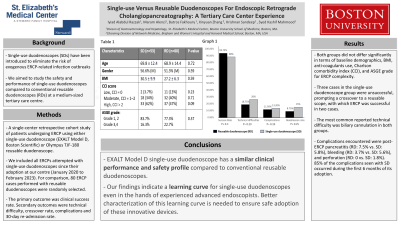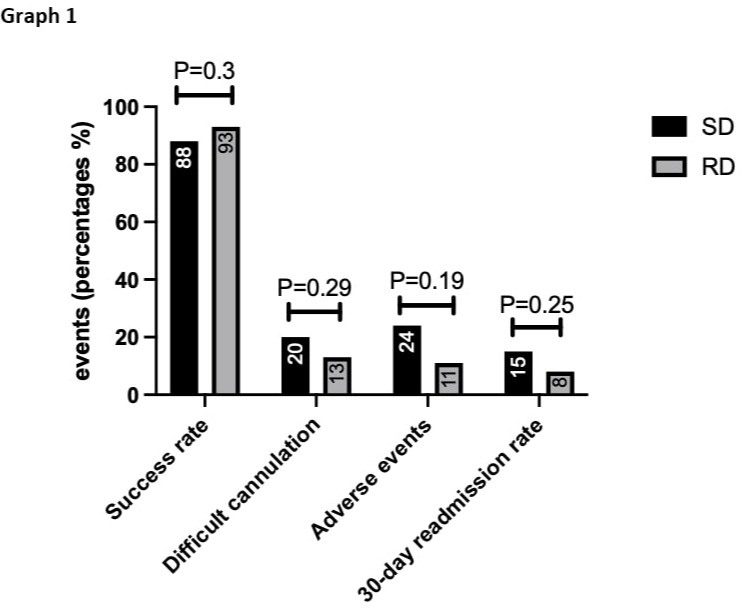Tuesday Poster Session
Category: Interventional Endoscopy
P3708 - Single-Use vs Reusable Duodenoscopes for Endoscopic Retrograde Cholangiopancreatography: A Tertiary Care Center Experience
Tuesday, October 24, 2023
10:30 AM - 4:00 PM PT
Location: Exhibit Hall

Has Audio

Iyiad Alabdul Razzak, MD
St. Elizabeth's Medical Center
Brighton, MA
Presenting Author(s)
Iyiad Alabdul Razzak, MD1, Maram Alenzi, MD1, Butros Fakhoury, MD2, Xinyuan Zhang, PhD3, Syed K. Mahmood, MD, MPH4, Sandeep Krishnan, MD, PhD4
1St. Elizabeth's Medical Center, Tufts School of Medicine, Brighton, MA; 2St. Elizabeth's Medical Center, Birghton, ME; 3Channing Division of Network Medicine, Brigham and Women’s Hospital, Boston, MA; 4St. Elizabeth's Medical Center, Brighton, MA
Introduction: Duodenoscopes are dependent on high-level reprocessing to prevent infection outbreaks. Despite that, exogenous contamination cannot be prevented, and infections with multi-drug resistant organisms have been linked to reusable duodenoscopes (RDs) contaminations. This led to the introduction and adoption of disposable, single use duodenoscopes (SDs). Data about SDs’ clinical effectiveness and safety in comparison with RDs is limited. We studied the feasibility, performance, and safety of SDs in comparison with RDs in patients undergoing ERCP.
Methods: This is a single center retrospective study of patients undergoing ERCP using SDs (EXALT Model D®) and RDs (Olympus TJF-180). Five expert endoscopists performed these procedures. We included all ERCPs attempted with SDs since their adoption at our center (January 2020 to February 2023). ERCP procedures performed using RDs during the first week of each month in 2022 were included. Outcomes analyzed included rates of successful ERCP completion for the intended indication, crossover from SDs to RDs, difficult biliary cannulation, serious adverse events, as well as total procedure time, and 30-day re-admission rate.
Results: A total of 133 ERCPs performed on adult patients were included. Of those, 53 procedures were attempted using SD and 80 using RD. Both groups were well matched (table 1). Procedure success rates were similar between the two groups (93.75% in RD group vs. 88% in SD group, P= 0.30). Nonetheless, three cases (5.6%) in the SD group were initially unsuccessful prompting crossover to RD. Two out of the three cases were successful with RD. Biliary cannulation was difficult in 11 cases (20.7%) in SDs group compared to 11 cases (13.7%) in the RDs group (P=0.29). Rates of adverse events were also similar (24.5% in SDs vs. 11.3% in RDs, ASGE-adjusted P=0.19). Of note, one bleeding event in the SDs group was due to a long (5 cm) linear gastric ulcer caused by direct scope trauma upon withdrawal. Mean total procedure time was comparable between both groups (48.4 min in SDs vs. 45.9 min in RDs, ASGE-adjusted P=0.49). Finally, there was no difference in 30-day readmission rates (15.4% in SDs vs. 8.9 in RDs, P=0.25) (graph 1).
Discussion: In this study, experienced endoscopists were able to perform a wide range of ERCPs using SDs with a success rate and safety comparable to RDs. Nevertheless, more research is needed to better characterize the learning curve for SDs to guide adoption of these innovative devices.

Disclosures:
Iyiad Alabdul Razzak, MD1, Maram Alenzi, MD1, Butros Fakhoury, MD2, Xinyuan Zhang, PhD3, Syed K. Mahmood, MD, MPH4, Sandeep Krishnan, MD, PhD4. P3708 - Single-Use vs Reusable Duodenoscopes for Endoscopic Retrograde Cholangiopancreatography: A Tertiary Care Center Experience, ACG 2023 Annual Scientific Meeting Abstracts. Vancouver, BC, Canada: American College of Gastroenterology.
1St. Elizabeth's Medical Center, Tufts School of Medicine, Brighton, MA; 2St. Elizabeth's Medical Center, Birghton, ME; 3Channing Division of Network Medicine, Brigham and Women’s Hospital, Boston, MA; 4St. Elizabeth's Medical Center, Brighton, MA
Introduction: Duodenoscopes are dependent on high-level reprocessing to prevent infection outbreaks. Despite that, exogenous contamination cannot be prevented, and infections with multi-drug resistant organisms have been linked to reusable duodenoscopes (RDs) contaminations. This led to the introduction and adoption of disposable, single use duodenoscopes (SDs). Data about SDs’ clinical effectiveness and safety in comparison with RDs is limited. We studied the feasibility, performance, and safety of SDs in comparison with RDs in patients undergoing ERCP.
Methods: This is a single center retrospective study of patients undergoing ERCP using SDs (EXALT Model D®) and RDs (Olympus TJF-180). Five expert endoscopists performed these procedures. We included all ERCPs attempted with SDs since their adoption at our center (January 2020 to February 2023). ERCP procedures performed using RDs during the first week of each month in 2022 were included. Outcomes analyzed included rates of successful ERCP completion for the intended indication, crossover from SDs to RDs, difficult biliary cannulation, serious adverse events, as well as total procedure time, and 30-day re-admission rate.
Results: A total of 133 ERCPs performed on adult patients were included. Of those, 53 procedures were attempted using SD and 80 using RD. Both groups were well matched (table 1). Procedure success rates were similar between the two groups (93.75% in RD group vs. 88% in SD group, P= 0.30). Nonetheless, three cases (5.6%) in the SD group were initially unsuccessful prompting crossover to RD. Two out of the three cases were successful with RD. Biliary cannulation was difficult in 11 cases (20.7%) in SDs group compared to 11 cases (13.7%) in the RDs group (P=0.29). Rates of adverse events were also similar (24.5% in SDs vs. 11.3% in RDs, ASGE-adjusted P=0.19). Of note, one bleeding event in the SDs group was due to a long (5 cm) linear gastric ulcer caused by direct scope trauma upon withdrawal. Mean total procedure time was comparable between both groups (48.4 min in SDs vs. 45.9 min in RDs, ASGE-adjusted P=0.49). Finally, there was no difference in 30-day readmission rates (15.4% in SDs vs. 8.9 in RDs, P=0.25) (graph 1).
Discussion: In this study, experienced endoscopists were able to perform a wide range of ERCPs using SDs with a success rate and safety comparable to RDs. Nevertheless, more research is needed to better characterize the learning curve for SDs to guide adoption of these innovative devices.

Figure: Outcomes analyzed comparing SD (black bars) to RD (gray bars) using chi-square test and logistic regression analysis
Disclosures:
Iyiad Alabdul Razzak indicated no relevant financial relationships.
Maram Alenzi indicated no relevant financial relationships.
Butros Fakhoury indicated no relevant financial relationships.
Xinyuan Zhang indicated no relevant financial relationships.
Syed Mahmood indicated no relevant financial relationships.
Sandeep Krishnan indicated no relevant financial relationships.
Iyiad Alabdul Razzak, MD1, Maram Alenzi, MD1, Butros Fakhoury, MD2, Xinyuan Zhang, PhD3, Syed K. Mahmood, MD, MPH4, Sandeep Krishnan, MD, PhD4. P3708 - Single-Use vs Reusable Duodenoscopes for Endoscopic Retrograde Cholangiopancreatography: A Tertiary Care Center Experience, ACG 2023 Annual Scientific Meeting Abstracts. Vancouver, BC, Canada: American College of Gastroenterology.
